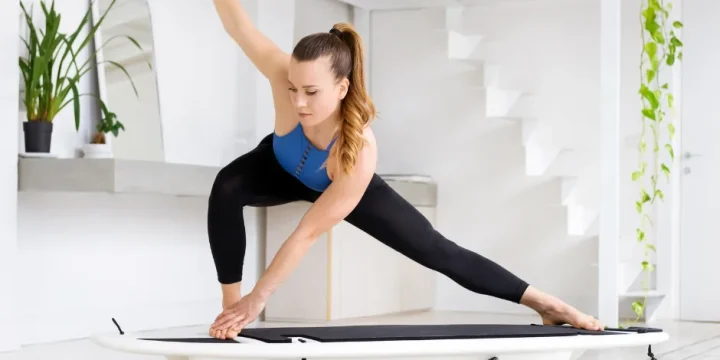I often incorporate exercises like lateral bounds into my clients’ workout routines, as they are simple yet effective bodyweight compound movements.
I’ve used them for years as a dynamic warm-up exercise or a high-intensity workout to improve my clients’ balance, agility, coordination, strength, and power.
In this article, I’ll show you how to perform lateral bounds with proper form to get the most out of this exercise.
Quick Summary
- This exercise involves frontal movement jumps (from right foot to left foot) that engage the lower body.
- Despite its numerous benefits, this compound movement may not be suitable for those with sensitive joints.
- Some variations of lateral bounds include using a medicine ball, 180-degree turns, single-leg bounds, and more.
- I personally find lateral bounds to be a game-changer for clients aiming to boost their dynamic strength and agility.
How to Perform This Exercise

This bodyweight workout requires no equipment to build muscle and is easy to learn, allowing you to perform it anywhere, whether at a park, home, or gym; Many of my clients have found it particularly convenient for home workouts, especially when they can't make it to the gym.
“Lateral bounds are a great exercise for improving agility, coordination, and power in the lower body”.
- Ross Enamait, Professional Boxing Coach
All you need is a flat surface to get started.
Step-by-Step Guide
Once you learn the technique properly, lateral bound can be used in various ways depending on your fitness goals.
Here’s how to do it:
- Starting position: stand with your feet shoulder-width apart and your knees slightly bent (in a half squat).
- Take a big step to your right with your right foot, keeping your left foot in place.
- Quickly push off with your right foot and jump to your left, landing on your left foot and bringing your right foot behind your left leg.
- Land softly on your left foot, absorbing the impact with a slight bend in your knee.
- Repeat the movement, jumping back to the right, and continue alternating sides for the desired number of repetitions or times.
Tips
To get most of the exercise during the whole movement, you should do the following:
- Use your hips and arms to accelerate and generate maximal force.
- Let your arms help you keep your balance and land softly (your landing on the ground should not be audible).
- Shift your weight to the outside hip when jumping from one leg to another.
- Try to jump with maximum height and distance while still maintaining body control.
- Until you get the feeling of how to land softly and absorb lateral force to maintain balance and joint stability, always start and stick to a single lateral bound.
Benefits and Drawbacks

Lateral bound, an athletic-based plyometric exercise, engages a complex biomechanical chain that activates multiple leg muscles, joints, feet, and stabilizer muscles in the core.
I've seen remarkable improvements in my clients' lower body strength and core stability after incorporating this exercise into their routines.
This exercise involves a sophisticated interplay of muscle coordination and joint movements, as detailed in biomechanical studies and reports by the National Institutes of Health [1].
As a result, this workout offers many benefits, including its role in rehabilitation and injury prevention, particularly for athletes recovering from lower limb injuries.
Yet, for the same reasons, it may also have some potential drawbacks you should be aware of.
Four Benefits
Being plyometric but also a calisthenic and cardiovascular exercise, lateral bound has many different benefits.
I've seen clients who initially struggled with endurance make significant improvements in their cardiovascular health through consistent lateral-bound workouts
Below are some of its benefits:
- Leg Explosive Power. The explosive nature of lateral bound involves and activates the triple extension of the lower body joints—ankles, knees, and hips—making it a key element in developing and maintaining athletic power.
- Leg Strength. Lateral bound engages quads, hamstrings, glutes, and calf muscles, stimulating their growth and stability.
- Balance and Coordination. This workout teaches how to accelerate, decelerate, and absorb force while moving in the frontal plane, promoting balance and coordination.
- Cardiovascular Endurance. Performed at a specific pace, this exercise elevates your heart rate and improves your muscular endurance.
The Drawbacks
There aren’t many serious drawbacks to lateral bound, but you should be aware of the following two:
- Hard on joints. Due to the high-impact nature of lateral bounds, these may not be suitable for those with joint pain or mobility issues.
- Requires balance and coordination. If you are new to fitness or have poor balance, it may take some time to master the movement and reduce the risk of injury.
Related Articles:
If you find that lateral bounds are either too easy or too difficult for your fitness level, there are alternative exercises you can try.
I often work with clients to find the right level of challenge, ensuring they're neither overexerting nor understimulated.
Four Lateral Bound Variations

You can use several variations of lateral bound to add variety to your workout routine or challenge yourself in different ways.
Here are the most common ones:
- Single-Leg Lateral Bounds. Instead of jumping off two feet, this variation requires you to perform a lateral bound on a single leg, increasing the difficulty.
- Lateral Bound with a Pause. Adding a halt at the end of each jump can increase your muscles’ time under tension, leading to more significant muscle growth and strength.
- Lateral Bound with a 180-Degree Turn. This variation involves jumping laterally and rotating 180 degrees mid-air before landing on the opposite foot, challenging your balance and coordination.
- Lateral Bound with a Medicine Ball. Adds extra difficulty and can help improve upper body strength and power.
Lateral bound and their variations can be seamlessly integrated into any training regimen, whether sports, circuit, or a fat burning high-intensity interval training.
In my practice, I've successfully incorporated them into various training programs, tailoring them to each client's unique fitness goals.
FAQs
How Many Sets and Reps for Lateral Bounds?
For lateral bounds, it’s best to start small—2 to 3 sets and a range of 10 to 20 reps per leg. As you become more experienced and comfortable with the movement, you can gradually increase the intensity by aiming for 3–5 sets or adjusting the number of reps accordingly.
What Muscles Lateral Bounds Targets?
Lateral bounds target several muscles in the lower extremities, including the quads, hamstrings, glutes, calf, and core muscles. Additionally, they engage the stabilizers in the feet, ankles, and core.
References:
- https://www.ncbi.nlm.nih.gov/pmc/articles/PMC5260592/
About The Author
You May Also Like






